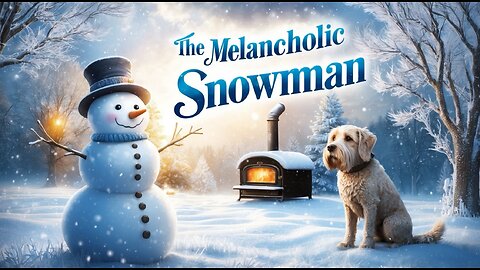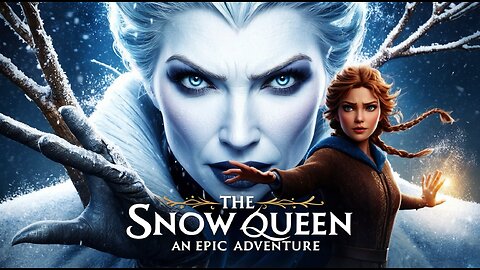
-
"The Melancholic SNOWMAN: A Winter Tale | Seasonal Change and the Beauty of Childhood Joy
WWinter tales you will ❤️ loveThe story of the Snow-man explores themes of existence, desire, and the inevitability of change. Created from the laughter and joy of children, the Snow-man embodies the enchantment of winter but quickly becomes aware of his fragile nature as he converses with an old yard-dog. The Snow-man feels the biting cold and contemplates the fiery sun, which he instinctively recognizes as an adversary. The yard-dog, representing experience and wisdom, explains the nature of the sun and moon to the naïve Snow-man, emphasizing that the sun will eventually cause him to melt away, as has happened to his predecessors. Amidst the beauty of a frosty morning, the Snow-man becomes captivated by a stove visible through a window, which he perceives as a symbol of warmth and comfort. The interaction between the Snow-man and the yard-dog highlights the contrast between different forms of existence: the transient beauty of winter versus the enduring presence of warmth represented by the stove. The Snow-man's longing to embrace the stove signifies a deep desire for identity and belonging, as he feels an inexplicable connection. As the day progresses, the Snow-man's admiration for the stove intensifies, illustrating the inner conflict between his ephemeral snowy form and the stable warmth that brings life—a desire that ultimately leads to his demise. When the thaw begins, it symbolizes the unavoidable cyclical change of seasons, resulting in the Snow-man's dissolution. The yard-dog, who has suffered similar challenges but has adapted over time, observes the melting of the Snow-man with a sense of resignation. In the end, the Snow-man’s existence turns into nothing more than a broomstick, leaving a poignant reflection on the transient nature of life and the bittersweet beauty of winter—a reminder that every delightful moment is fleeting, reinforcing the notion that everything changes, and winter will ultimately give way to spring. The narrative merges the whimsical with a profound observation of existential fate and the longing for warmth and connection.14 views -
The Snow Queen: A Magical Tale | Love and Adventure in Classic Literature
FFantasy and Enchantments"The Snow Queen," a tale by Hans Christian Andersen, begins with a mischievous demon creating a magical looking-glass that distorts reality, diminishing beauty and magnifying ugliness. This mirror shatters, scattering fragments that corrupt perceptions, causing those who encounter them to see only the worst in the world. The story follows two children, Kay and Gerda, who share a special bond but are soon separated when Kay, affected by a shard of the looking-glass, falls under the influence of the Snow Queen. Gerda's journey to find him sees her fighting through sorrow, eventually leading her to the Snow Queen's palace. While Gerda seeks Kay, he is captured by the Snow Queen and forgets their friendship. Gerda, determined and brave, encounters various characters along her journey, including a helpful crow who informs her that Kay may reside with a princess. The princess has set a challenge for suitors: to speak with her without becoming speechless, which none had accomplished. However, Kay enters her court with confidence, impressing her with his knowledge and charm. Despite his success, Gerda's love and determination lead her deeper into the quest to rescue Kay from the Snow Queen’s icy grasp. Her journey symbolizes a quest for love, innocence, and the strength of friendship against the harsh realities introduced by the demon's looking-glass. Ultimately, the core message reflects the struggle between good and evil, showcasing how love and willpower can overcome darkness. In the end, Gerda's persistent love triumphs as she breaks the spell the shard had cast over Kay, restoring his heart and their friendship. Their union reinforces the story's themes of resilience, the purifying power of love, and the significance of remaining true to one’s heart amidst adversities. This tale serves as an allegory for the perils of losing sight of one’s humanity in a flawed world.15 views -
The Snowman Paradox: childhood Innocence and the Weight of Existence #fantasy, magical realism
WWinter tales you will ❤️ loveThe narrative revolves around a snowman, created by a girl named Rosemary Dincer, who reflects on his existence and the world around him. The snowman, embodying both snow and human traits, experiences a profound sense of awareness after his creation. He muses on the juxtaposition of life and death, the nature of existence, and the fleeting essence of human experience. Despite his crafted, immobile form, he feels a sense of freedom in his static state, contrasting with the complexities and burdens of human life, notably growth and change that affect humans over time. The snowman observes the Dincer family and their suburban life, gaining insights from the Perpetual Snowflake, a whimsical metaphorical entity that enlightens him about the world’s impermanence and interconnectedness. As he gazes outward, he contemplates the nature of ownership and belonging, realizing he is both a common object for children and a unique creation linked to his maker. The snowman epitomizes innocence and simplicity against a backdrop of human complexity. He witnesses children engaging with the snow (and by extension, him) in playful ways, expressing untouched joy that starkly contrasts adults’ burdens. This contrast heightens his awareness of human despair—illustrated through the characters surrounding him, particularly Harry Dincer, whose alcoholism foreshadows a deeper societal malaise tied to unfulfilled desires. Through the snowman’s perspective, the narrative highlights the continuous strive for meaning amid the chaos of modern living, where connection often eludes individuals despite their desperate longing for communication and understanding. The Perpetual Snowflake enhances this thread by indicating the lack of real comprehension in human existence, suggesting that most live superficially, devoid of deeper emotional engagement. As the snowman’s reflection deepens, he encounters feelings of sadness and existential dread, stemming from an acute separation from the realm from which he originated—the sky filled with snow, innocence, and purity. His musings evoke themes of temporality; he grapples with the reality of existence as fragile and transient, where the act of making snowmen signifies a fleeting moment of joy that quickly melts away. Through contemplating life’s transience, the snowman symbolizes a form of immortality, exploring the notion that although he is physically temporary, his essence coexists with the natural world, contributing to cycles of life and memory beyond his actual physical presence. Dangers like fire, which represent destruction and the inevitability of death, loom over his existence, emphasizing the fragility of life. In stark contrast to the joyous creation of snowmen stands the notion of chaos and destruction lingering within the human experience. The snowman’s observations lead him to perceive the cycle of creation and destruction in human lives, where experiences shape and define existence within an unsettling permanence characterized by despair, loneliness, and the pursuit of unattainable dreams. Humans deal with pain, fear, and emotion that often lead to disconnect from themselves and others, showcasing an ongoing clash between appearance and true essence. The snowman’s enlightenment unfolds incrementally; he learns that human beings are centralized around striving to define themselves against the backdrop of societal roles, expectations, and constructed identities. The narrative details interactions among various families in the neighborhood, symbolizing broader social dynamics and the intricacies of community life, each character burdened by their own narratives of struggle and desire. These interactions convey the idea that, while individuals seek belonging and connection, they also harbor misunderstandings and prejudices rooted in fear and survival mechanisms. In a moment of transcendence, still stemming from his static, snow-formed body, the snowman reflects on the paradox of existence: the desire for permanence within an impermanent world. He observes that, unlike humans bound by physical and emotional evolution, he embodies a static existence—a snapshot of creation impervious to time. This evokes a poignant commentary on the human condition, illustrating how the pressures of everyday life reshape perceptions and incite existential contemplation around identity, purpose, and interconnectedness amidst a cacophony of voices—all searching for meaning but often coming away with pain, alienation, and a longing for true connection. Ultimately, the snowman embodies a paradoxical longing for both connection and solitude; he craves understanding and to witness human life while simultaneously experiencing the safety of his immobile state. The continuous snowfall serves as a metaphor for hope, rebirth, and the cyclical nature of existence, even as the snowman ponders the stark reality of existence on a paradoxical continuum—where joyful creation brings about fleeting existence, and the inevitable return to earth, and thus challenges us to reflect on our own connections, perceptions, and the tapestry of lives we weave within a shared, yet solitary human experience. The snowman stands as a vessel of reflection, urging readers to contemplate the complexities of their own existence and relationships, driving home the poignant themes of mortality, connection, and the pursuit of meaning in a transient world where snowflakes eventually vanish but their essence lingers.25 views 1 comment -
Adventures of the Gingerbread Man: A Whimsical Baking Tale!
WWinter tales you will ❤️ loveIn "The Little Gingerbread Man," a cook prepares gingerbread for the children, crafting a playful gingerbread man, whom she places in the oven. Upon baking, the gingerbread man springs to life, quickly escaping the kitchen and prompting a humorous chase. As he dashingly makes his way outside, the cook calls for her lazy cat, Mouser, to catch him. However, Mouser, still drowsy, only gets up when urged again, but the gingerbread man cleverly evades capture. The cook continues the pursuit, calling for Towser, the dog, who also starts off in confusion, thinking Mouser is the target. In the commotion, the cat and dog end up in a tangled heap after their clumsy encounter, while the gingerbread man watches and laughs from the safety of the garden wall. As the chase evolves, the gingerbread man confidently runs into a field, where he next encounters Jocko, a monkey. The monkey jumps after him but mistakenly lands on Towser, who bites his tail. In a moment of triumph, the gingerbread man climbs a tree, believing he is safe from his pursuers. Yet, Jocko skillfully follows him and grabs the gingerbread man, just as Bobby, the child for whom the gingerbread was made, arrives on the scene. Bobby exclaims for Jocko to drop the gingerbread man, which he promptly does. Bobby, driven by hunger, takes big bites of the gingerbread man, who comically announces the loss of his parts with each bite. As Bobby consumes the gingerbread man entirely, he realizes he has eaten him completely. The narrative illustrates themes of curiosity, mischief, and humor, encapsulating the playful nature of childhood and the whimsical adventures of the gingerbread man as he navigates his world, ultimately meeting a humorous yet inevitable end.27 views -
Buddy the Elf's Hilarious Journey: Finding Family and Spreading Christmas Cheer in New York City
WWinter tales you will ❤️ loveBuddy the Elf, having grown up in the North Pole, embarks on a heartfelt journey to find his biological father, Walter Hobbs, in New York City after learning that he is not an elf but a human. With unwavering enthusiasm, Buddy navigates the bustling metropolis, encountering humorous mishaps and the indifference of city dwellers, all while spreading Christmas cheer with his infectious spirit. Despite being mistaken for a Christmas-gram delivering erratic joy, he remains steadfast in his quest to connect with his father. Along the way, he brightens the drab environment of Gimbels Department Store with his unbridled excitement, contrasting sharply with the mundane lives of the people around him. As he decorates Santa Land and prepares for Santa's arrival, Buddy's world is filled with whimsical moments, laughter, and a renewed sense of purpose, showcasing a unique blend of innocence and determination as he seeks love and acceptance in a place that initially feels foreign to him.33 views 1 comment -
A Kidnapped Santa Claus: The Magical Tale of Santa's Rescue and Holiday Adventure
WWinter tales you will ❤️ loveIn the enchanting tale of "A Kidnapped Santa Claus," the beloved figure of Santa faces an unexpected crisis when he is captured by the wicked Daemons jealous of the joy he brings to children around the world. As Christmas Eve approaches, the stakes rise high with the fate of the holiday hanging in the balance. Meanwhile, Santa's loyal group of magical companions must embark on a daring mission to save him and ensure that the spirit of giving remains alive. With a mix of adventure, friendship, and redemption, this delightful story reminds us that love and joy can conquer even the darkest of intentions.41 views 1 comment




